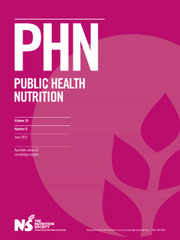Monitoring and surveillance
Research paper
Food insecurity, food skills, health literacy and food preparation activities among young Canadian adults: a cross-sectional analysis
-
- Published online by Cambridge University Press:
- 02 March 2021, pp. 2377-2387
-
- Article
-
- You have access
- HTML
- Export citation
Dietary fluoride intake over the course of pregnancy in Mexican women
-
- Published online by Cambridge University Press:
- 19 February 2021, pp. 2388-2396
-
- Article
-
- You have access
- HTML
- Export citation
Assessing nutritional value of ready-to-eat breakfast cereals in the province of Quebec (Canada): a study from the Food Quality Observatory
-
- Published online by Cambridge University Press:
- 12 April 2021, pp. 2397-2404
-
- Article
-
- You have access
- HTML
- Export citation
Short Communication
Trends and patterns in sugar-sweetened beverage consumption among children and adults by race and/or ethnicity, 2003–2018
- Part of:
-
- Published online by Cambridge University Press:
- 12 April 2021, pp. 2405-2410
-
- Article
-
- You have access
- HTML
- Export citation
Research paper
Breast-feeding promotion in hospitals and prospective breast-feeding rates during the first year of life in two national surveys 1997–1998 and 2017–2019 in Germany
-
- Published online by Cambridge University Press:
- 16 March 2021, pp. 2411-2423
-
- Article
-
- You have access
- HTML
- Export citation
Contribution of food groups to energy, grams and nutrients-to-limit: the Latin American Study of Nutrition and Health/Estudio Latino Americano de Nutrición y Salud (ELANS)
-
- Published online by Cambridge University Press:
- 12 April 2021, pp. 2424-2436
-
- Article
-
- You have access
- HTML
- Export citation
Assessment and methodology
Research paper
Identification and reproducibility of dietary patterns assessed with a FFQ among women planning pregnancy
-
- Published online by Cambridge University Press:
- 22 March 2021, pp. 2437-2446
-
- Article
-
- You have access
- HTML
- Export citation
Stepwise tailoring and test–retest of reproducibility of an ethnic-specific FFQ to estimate nutrient intakes for South Asians in New Zealand
-
- Published online by Cambridge University Press:
- 22 March 2021, pp. 2447-2454
-
- Article
-
- You have access
- HTML
- Export citation
Developing an online food composition database for an Indigenous population in south-western Uganda
-
- Published online by Cambridge University Press:
- 12 April 2021, pp. 2455-2464
-
- Article
-
- You have access
- Open access
- HTML
- Export citation
Nutritional status and body composition
Research paper
Established diet quality indices are not universally associated with body composition in young adult women
-
- Published online by Cambridge University Press:
- 06 April 2021, pp. 2465-2472
-
- Article
-
- You have access
- HTML
- Export citation
Behavioural nutrition
Research paper
An investigation of consumers’ use of ‘dessert-only’ food retail outlets: a mixed-methods study
-
- Published online by Cambridge University Press:
- 07 September 2020, pp. 2473-2482
-
- Article
-
- You have access
- HTML
- Export citation
Gender differences in factors associated with body weight misperception
-
- Published online by Cambridge University Press:
- 28 September 2020, pp. 2483-2495
-
- Article
-
- You have access
- HTML
- Export citation
Short Communication
Correlates of sugar-sweetened beverage intake among low-income women during the first 1000 days
-
- Published online by Cambridge University Press:
- 22 October 2020, pp. 2496-2501
-
- Article
-
- You have access
- HTML
- Export citation
Research paper
Investigating differences between traditional (paper bag) ordering and online ordering from primary school canteens: a cross-sectional study comparing menu, usage and lunch order characteristics
-
- Published online by Cambridge University Press:
- 27 October 2020, pp. 2502-2511
-
- Article
-
- You have access
- HTML
- Export citation
Validity and reliability of the Iranian version of the Yale Food Addiction Scale for obese women
-
- Published online by Cambridge University Press:
- 12 October 2020, pp. 2512-2520
-
- Article
-
- You have access
- HTML
- Export citation
Family structure and affluence in adolescent eating behaviour: a cross-national study in forty-one countries
-
- Published online by Cambridge University Press:
- 27 October 2020, pp. 2521-2532
-
- Article
-
- You have access
- HTML
- Export citation
Parental food choices for children when eating out: attitudes and impact of healthy choice menu labelling based on a hypothetical scenario
-
- Published online by Cambridge University Press:
- 23 October 2020, pp. 2533-2541
-
- Article
-
- You have access
- HTML
- Export citation
Meal and snack patterns of 7–13-year-old schoolchildren in southern Brazil
-
- Published online by Cambridge University Press:
- 29 October 2020, pp. 2542-2553
-
- Article
-
- You have access
- HTML
- Export citation
Nutritional epidemiology
Research paper
Associations of dietary diversity with anaemia and iron status among 5- to 12-year-old schoolchildren in South Africa
-
- Published online by Cambridge University Press:
- 03 July 2020, pp. 2554-2562
-
- Article
-
- You have access
- HTML
- Export citation
The association of the glucokinase rs4607517 polymorphism with gestational diabetes mellitus and its interaction with sweets consumption in Chinese women
-
- Published online by Cambridge University Press:
- 02 June 2020, pp. 2563-2569
-
- Article
-
- You have access
- HTML
- Export citation

